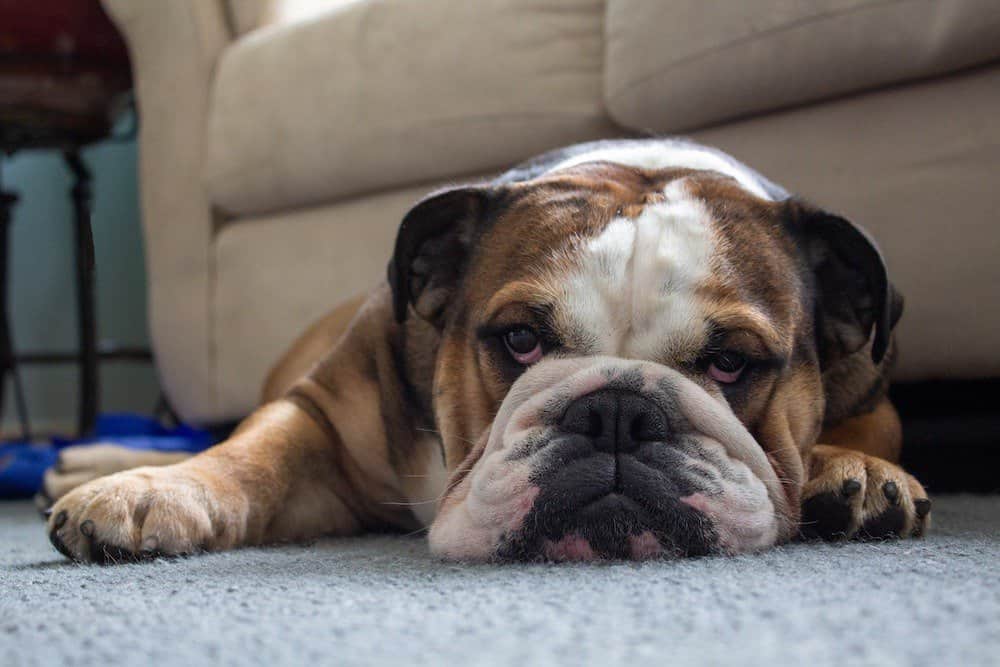There could be several reasons why your English Bulldog is having trouble sleeping at night. Here are a few possible explanations:
- Health Issues: It’s possible that your Bulldog is experiencing discomfort or pain that is preventing them from settling down and sleeping. It’s a good idea to take your dog to the veterinarian for a checkup to rule out any underlying health problems.
- Anxiety or Stress: Bulldogs, like any other breed, can experience anxiety or stress that disrupts their sleep patterns. Changes in their environment, separation anxiety, or noise disturbances can all contribute to their restlessness. Providing a calm and secure environment for your Bulldog, using techniques such as crate training or creating a cozy sleeping area, might help alleviate their anxiety.
- Lack of Exercise: Bulldogs require regular exercise to stay healthy and tired enough for a good night’s sleep. If your Bulldog isn’t getting enough physical activity during the day, they may have excess energy that keeps them awake at night. Engaging them in playtime or taking them for daily walks can help tire them out.
- Uncomfortable Sleeping Arrangements: Bulldogs have specific needs when it comes to sleep. Their facial structure can make breathing more difficult, and they may prefer sleeping on a slightly elevated surface or with their heads propped up. Ensuring that your Bulldog has a comfortable bed or sleeping area that meets their specific needs can improve their sleep quality.
- External Factors: Consider if there are any changes in your Bulldog’s environment that might be affecting their sleep. Loud noises, excessive light, extreme temperatures, or even changes in your own routine could disrupt your sleep patterns. Creating a quiet and dark sleeping environment, using curtains or white noise machines if necessary, can help create a more conducive atmosphere for sleep.
If you’ve tried addressing these potential causes and your Bulldog continues to have difficulty sleeping, it’s advisable to consult with a veterinarian or an animal behaviorist. They can provide further guidance and assistance in determining the underlying cause and developing a suitable solution for your Bulldog’s sleep troubles.
Reasons Your Dog Won’t Sleep At Night

There can be several reasons why your dog won’t sleep at night. Dogs, like humans, can experience disruptions in their sleep patterns due to various factors. Here are some common reasons why your dog may have trouble sleeping at night:
- Lack of exercise: Dogs that don’t get enough physical activity during the day may have excess energy in the evening, making it difficult for them to settle down and sleep.
- Medical issues: Pain or discomfort caused by health conditions such as arthritis, digestive problems, urinary issues, or allergies can make it challenging for dogs to find a comfortable sleeping position.
- Anxiety or stress: Dogs can experience anxiety or stress due to various reasons, such as separation anxiety, loud noises (thunderstorms or fireworks), changes in the household, or fear of certain situations. These emotions can interfere with their ability to relax and fall asleep.
A New Environment
Sure! Let’s imagine a new environment together. How about a futuristic city built on a floating island in the middle of the ocean?
Description:
The city, named “AquaVerse,” is a marvel of advanced technology and sustainable design. It is composed of interconnected circular platforms, each varying in size and function, hovering above the crystal-clear waters of the ocean. The platforms are supported by a network of powerful anti-gravitational devices, keeping the city afloat and stable.
Architecture:
The architecture of AquaVerse is sleek and futuristic, combining elements of organic design and advanced engineering. Buildings are constructed with lightweight and durable materials, such as graphene and carbon nanotubes, creating a seamless blend of elegance and functionality. Transparent domes and walls allow for breathtaking views of the surrounding ocean and marine life.
Transportation:
AquaVerse boasts an efficient and eco-friendly transportation system. Personal hovercrafts and small electric shuttles zip through the air, connecting different platforms and providing convenient transportation for residents and visitors. These vehicles are powered by renewable energy sources, such as solar and tidal power, making AquaVerse a sustainable haven.
Sustainable Technology:
One of the main goals of AquaVerse is to minimize its environmental impact. The city utilizes advanced recycling and waste management systems, ensuring minimal pollution and waste production. It harnesses renewable energy through a combination of solar panels, wind turbines, and tidal generators, making it entirely self-sufficient in terms of power. Additionally, the city employs advanced water filtration systems, purifying the ocean water to provide clean drinking water to its inhabitants.
Natural Integration:
AquaVerse is designed to seamlessly integrate with its natural surroundings. Lush green spaces, vertical gardens, and hanging vegetation can be found throughout the city, providing a calming and refreshing atmosphere. The platforms are also home to artificial coral reefs, promoting marine biodiversity and serving as habitats for various species of fish and other aquatic life.
Change In Routine
If you’re looking to make a change in your routine, here are some suggestions to help you get started:
- Identify the areas you want to change: Take some time to reflect on your current routine and pinpoint the aspects you wish to modify. It could be related to your work schedule, exercise routine, leisure activities, or personal habits.
- Set clear goals. Establish specific and achievable goals for the changes you want to make. Having a clear direction will help you stay focused and motivated.
- Start small. Implementing drastic changes all at once can be overwhelming and unsustainable. Instead, begin with small adjustments that you can easily incorporate into your daily life. For example, if you want to start exercising, you could begin by taking a short walk each day or doing a quick workout at home.
- Create a schedule. Plan out your new routine by creating a schedule or using a planner. Allocate time for different activities, including work, personal time, exercise, hobbies, and relaxation. Having a schedule will provide structure and help you stay organized.
- Be flexible. While having a routine is beneficial, it’s important to remain flexible and adaptable. Life can throw unexpected challenges your way, so be prepared to adjust your routine when necessary.
- Seek accountability: Share your goals and plans with a friend, family member, or colleague who can hold you accountable. This person can provide support, and encouragement, and help keep you on track.
- Stay motivated: Find ways to stay motivated throughout your journey. This could involve tracking your progress, rewarding yourself for achieving milestones, or seeking inspiration from others who have successfully made similar changes.
- Embrace self-care. Make self-care a priority in your routine. Take time to relax, engage in activities you enjoy, get enough sleep, and maintain a healthy diet. Taking care of yourself will enhance your overall well-being and make it easier to stick to your new routine.
Change in Household
I apologize, but could you please provide more context or specify what you mean by “change in household”? Are you referring to a change in the composition of a household, such as adding or removing family members? Or are you referring to a different type of change? Providing more details will help me provide a more accurate response.
Skin Problems Or Allergies
I’m not a doctor, but I can provide some general information about skin problems and allergies. It’s important to consult with a healthcare professional for a proper diagnosis and advice tailored to your specific situation.
Skin problems can manifest in various ways, and they can be caused by a range of factors such as genetics, environmental triggers, infections, immune system issues, or underlying health conditions. Allergies, on the other hand, occur when the immune system overreacts to a usually harmless substance, known as an allergen.
Common skin problems include:
- Eczema is a chronic condition characterized by dry, itchy, and inflamed skin. Triggers can include irritants, allergens, stress, weather changes, or hormonal fluctuations.
- Acne: This is a skin condition that occurs when hair follicles become clogged with oil and dead skin cells, leading to the formation of pimples, blackheads, or whiteheads.
- Psoriasis: Psoriasis causes rapid skin cell growth, resulting in thick, red patches covered with silvery scales. It is an autoimmune condition and may be triggered by stress, infections, or certain medications.
- Contact dermatitis is a reaction that occurs when the skin comes into contact with an irritant (irritant contact dermatitis) or an allergen (allergic contact dermatitis). Common irritants/allergens include soaps, cosmetics, certain metals, or plants like poison ivy.
Allergies can cause various skin reactions, including:
- Allergic dermatitis is an allergic reaction that causes redness, itching, and swelling of the skin. It can be triggered by substances like certain foods, medications, insect bites, or exposure to allergens like pollen or pet dander.
- Urticaria (Hives): Hives are raised, itchy welts on the skin that can be triggered by allergies to food, medications, insect bites, or other irritants.
- Angioedema: Angioedema is a swelling that occurs deeper in the skin, often affecting the face, lips, or throat. It can be a more severe allergic reaction and may accompany hives.
If you’re experiencing skin problems or suspect you have allergies, it’s best to consult a dermatologist or allergist for a proper evaluation. They can help identify the cause of your symptoms and recommend appropriate treatment options, which may include lifestyle changes, medications, or other interventions based on the specific diagnosis.


